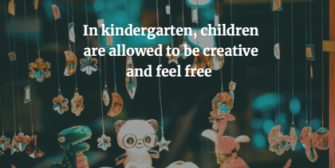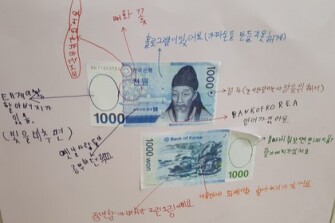Editor’s Note: Monica Schnee, English as a Second Language (ESL) Program Coordinator at the River Edge Public School District in New Jersey, traveled to Korea as a Fulbright Distinguished Awards in Teaching Program recipient. In Korea, she researched English language education in the elementary grades and English language teacher preparation. Here she shares some of her observations on kindergarten.
South Korea consistently ranks among the top performing countries in the Program for International Student Assessment or PISA, and it’s known for both academic excellence and for deeply valuing education and the teaching profession.

Today, Korean children are raised to become professional students with the goal of entering the most prestigious universities. These demands begin at a young age. Children study at school from textbooks that follow the national curriculum and they still write on notebooks instead of using laptops. However, in the land where education and hard work reign, there is one place where the rigor lessens and children are allowed to be creative and feel free. That place is kindergarten.
Early Childhood and Kindergarten Education
Based on my experience working with Korean families in New Jersey, I had learned two significant facts about early/primary education in Korea: formal schooling begins in first grade and Korean age is calculated by adding one more year because babies are considered one year old at birth. This is extremely relevant in terms of child development and readiness to learn the skills of reading and writing.
Once in Korea, I learned that kindergarten education is based on the Montessori philosophy and follows the “Nuri (World)” state curriculum adopted in 2012. The goals set in the Korean Proclamation of the Ministry of Education and Human Resources Development, 2007 are still relevant today and help shed light on how Korea sees education at this grade level:
1. To promote healthy development of the mind and body and acquire basic living habits.
2. To acquire skills for living together and love for traditional culture.
3. To enable young children to express their own thoughts and feelings in creative ways.
4. To develop language skills for communication and proper language use.
5. To explore the environment with curiosity and to respect nature.
My visits to two different kindergartens in Seoul, one public and one private, allowed me to observe classroom practices that aligned with these goals. The visits were followed by conversations with the principals, teachers, and staff. In addition, I interviewed educators at other private schools.
The private kindergarten is “an attached school.” Many universities in Korea are affiliated with private schools. These schools generally provide English language instruction beginning in grade 1, whereas public schools begin teaching English in grade 3.
The public kindergarten is part of the elementary school and like the private one, it is housed in a separate building for children ages 3-6. Both schools had up to 20 students per class with one teacher and one aide.
The classrooms were filled with musical instruments, toys, science centers with pets, plants, rocks, shells, puzzles, and tables and chairs made for “little bodies” very close to the floor. The private school had no computers or screens, while the public school had one computer and a large screen used to display children’s work or to play music. There were no teachers’ desks—teachers work in a central office, and the rooms are for the children.
Both schools implement a play-oriented, child-centered approach with an emphasis on autonomy, creativity, and the encouragement to express feelings. The development of mind and body and learning about traditional culture take center stage in kindergarten.

In both schools, language, literacy, and numeracy are taught through play, songs, read-alouds, and crafts. Baskets filled with play foods, containers with beads for sorting, beans in bowls with chopsticks, yarn and needles to be threaded were all set out to develop fine motor skills and dexterity. In addition, each room contained an abacus and real money to teach math and social studies; rocks and leaves to teach science; traditional dolls and puppets to teach about history and traditions; and papers, markers, and white boards to encourage writing.
No charts are on the walls, no phonics rules or alphabet charts. These skills are taught in first grade. Korean kindergarten teachers do not administer formal summative assessments of reading, writing, and math skills. Assessments are observational through checklists, narratives, and portfolios.
Focus, Focus, Focus
As the children come into the classroom, they join their friends or play by themselves. After 30 minutes, they sit in a circle to sing a hello song. There is a lot of movement as children get up and walk around as needed. In both schools where I observed, children and teachers left the rooms freely, but most children did not appear to feel they needed to leave the room.
The kindergartners in the public school had planted sweet potato seeds in the spring. Attentively watching themselves on the big screen, they retold all the steps they followed in order to plant and harvest the vegetables. They were using science content language, sequential words, and taking turns as they described the different visuals. The next science lesson was washing, cutting, and cooking the sweet potatoes. Learning was authentic, meaningful, and owned by the students. They were proud and excited to taste the “fruits of their labor!”
As I observed the dynamics in both classrooms, I noticed that class management was not a problem. There was no raising one’s hand to participate in conversations, no assigned seating, no shifting from block to block. Focusing issues and hyperactivity were strikingly absent from the classrooms. The more relaxed environment, the freedom to move around, the stress on independence, and the attention required to work on tasks demanding dexterity benefited the children in many different ways. Such a setting promotes the development of the skills, diligence, and endurance that will be expected of students as they go up the grades.
Small group instruction was “organic.” Students picked an area where they worked together and the teacher moved from group to group. They were not leveled by ability but they gravitated toward their interests, which in some ways differentiated the instruction. Teachers were facilitators of learning in a country where instruction is teacher centered beginning in first grade. Teachers are in charge of teaching all subject areas including gym, music, and art. Specialists come in to support teaching of certain subjects, but teachers must be present during those classes.
Building Community
As lunchtime approached, the teachers asked the children to write today’s menu. Children ran to the white boards to write the soup, vegetable, meat, kimchi, rice, and dessert for the day. Those who did not write the menu sat down to write stories or moved to a different area.
Both schools offered lunch in the classroom. As a rule, teachers at all grade levels eat with their students either in their classrooms or cafeterias for the upper grades. Everyone eats the same food, a balanced diet. Everyone cleans their trays disposing of the food in a composting bin and stacking trays and utensils in a particular order. This daily routine develops communal responsibility, care for the environment, and an appreciation for meal times. Lunch takes approximately one hour not including recess, stressing the importance of food. All schools have a nutritionist on staff.
Lunch at the public school is free for students and teachers pay a nominal fee. There are no students who forget their lunches, no food allergy tables. If a student can’t eat something, the nutritionist knows and takes care of it individually. There are no lunch duties and recess duties for teachers. Everyone is part of the community of learners.
After lunch, everyone, including teachers, brushed their teeth during “gargle time.” Each child was responsible for their own toothbrush and cup. They were taught to take their time to brush their teeth properly, promoting hygiene and independence in a communal setting.
The end of the kindergarten school day at the public school was 1:30 pm, right after lunch. The private school dismissed students at 2:00 pm. Both schools gave children a chance to play outside before going home. Outdoor play is part of the curriculum.
Although many children stay for afterschool programs until their parents get them or go to private academies, many children go home. No matter what they do after school, their school day gives them the chance to be children, to learn through play.
Teachers stay in school until 4:00 pm preparing lessons, working collaboratively with peers, learning from different professional development opportunities, and communicating with parents.
Kindergarten in Korea lays the foundation for independence and helps children build focus and stamina for the rigor they will face in the higher grades while respecting the differences in cognitive development at the beginning of the K-12 continuum.
Connect with Monica and Heather on Twitter.
Quote image created on Pablo.
Korean money image taken by and used with permission of the author.




